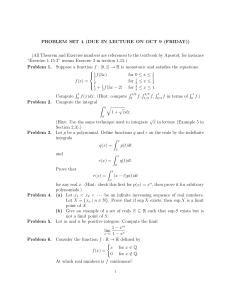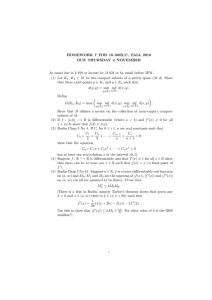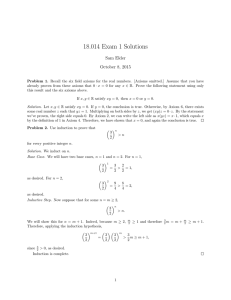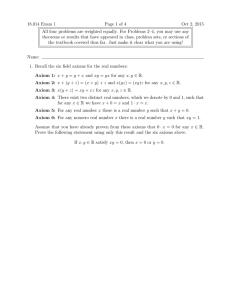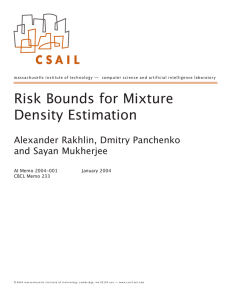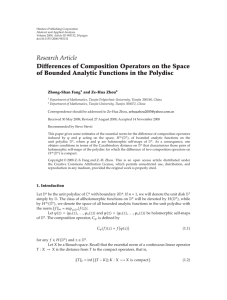Scattering calculus
advertisement
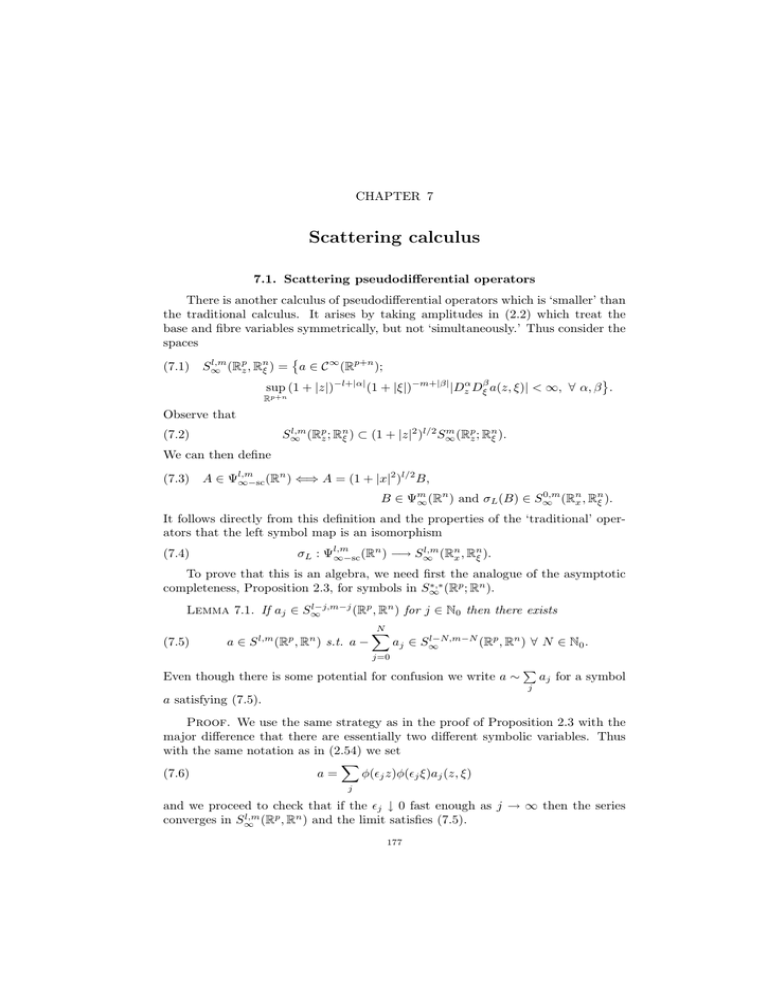
CHAPTER 7 Scattering calculus 7.1. Scattering pseudodifferential operators There is another calculus of pseudodifferential operators which is ‘smaller’ than the traditional calculus. It arises by taking amplitudes in (2.2) which treat the base and fibre variables symmetrically, but not ‘simultaneously.’ Thus consider the spaces l,m (7.1) S∞ (Rpz , Rnξ ) = a ∈ C ∞ (Rp+n ); sup (1 + |z|)−l+|α| (1 + |ξ|)−m+|β| |Dzα Dξβ a(z, ξ)| < ∞, ∀ α, β . Rp+n Observe that l,m m S∞ (Rpz ; Rnξ ) ⊂ (1 + |z|2 )l/2 S∞ (Rpz ; Rnξ ). (7.2) We can then define (7.3) n 2 l/2 A ∈ Ψl,m B, ∞−sc (R ) ⇐⇒ A = (1 + |x| ) n 0,m n n B ∈ Ψm ∞ (R ) and σL (B) ∈ S∞ (Rx , Rξ ). It follows directly from this definition and the properties of the ‘traditional’ operators that the left symbol map is an isomorphism n l,m n n σL : Ψl,m ∞−sc (R ) −→ S∞ (Rx , Rξ ). (7.4) To prove that this is an algebra, we need first the analogue of the asymptotic ∗,∗ (Rp ; Rn ). completeness, Proposition 2.3, for symbols in S∞ l−j,m−j Lemma 7.1. If aj ∈ S∞ (Rp , Rn ) for j ∈ N0 then there exists (7.5) a ∈ S l,m (Rp , Rn ) s.t. a − N X l−N,m−N aj ∈ S∞ (Rp , Rn ) ∀ N ∈ N0 . j=0 Even though there is some potential for confusion we write a ∼ P aj for a symbol j a satisfying (7.5). Proof. We use the same strategy as in the proof of Proposition 2.3 with the major difference that there are essentially two different symbolic variables. Thus with the same notation as in (2.54) we set X (7.6) a= φ(j z)φ(j ξ)aj (z, ξ) j and we proceed to check that if the j ↓ 0 fast enough as j → ∞ then the series l,m converges in S∞ (Rp , Rn ) and the limit satisfies (7.5). 177 178 7. SCATTERING CALCULUS The first of the seminorms, for convergence, is Aj = sup sup(1 + |z|)−l (1 + |ξ|)−m φ(j z)φ(j ξ)|aj (z, ξ)|. z ξ On the support of this function either |z| ≥ 1/j or |ξ| ≥ 1/. Thus Aj ≤ sup sup(1 + |z|)−l+j (1 + |ξ|)−m+j |aj (z, ξ)| z ξ × sup sup(1 + |z|)−j (1 + |ξ|)−j φ(j z)φ(j ξ) z ξ ≤ jj sup sup(1 + |z|)−l+j (1 + |ξ|)−m+j |aj (z, ξ)| z ξ l−j,m−j The last term on the right is a seminorm on S∞ (Rp , Rn ) so convergence follows by choosing the j eventually smaller than a certain sequence of positive numbers. The same argument follows, as in the discussion leading to (2.56), for convergence of the series for the derivatives and also for the stronger convergence leading to (7.5). Since overall this is a countable collection of conditions, all can be arranged by diagonalization and the result follows. With this result on asymptotic completeness the proof of Theorem 4.1 can be followed closely to yield the analogous result on products. In fact we can also define polyhomogeneous operators. This requires a little work if we try to do it directly. However see (1.97) and Problem 1.17 which encourages us to identify (7.7) 0,0 (Rp , Rn ) ←→ C ∞ (Sp,1 × Sn,1 ), RC∗p × RC∗n : Sph l,m 0,0 Sph (Rp , Rn ) = (1 + |z|2 )l/2 (1 + |ξ|2 )m/2 Sph (Rp , Rn ), l, m ∈ R. These definitions are discussed as problems starting at Problem 1.18. Thus we simply define o n l,m l,m n n n (7.8) Ψl,m sc (R ) = A ∈ Ψ∞−sc ; σL (A) ∈ Sph (R , R ) . n n l,m Theorem 7.1. The spaces Ψl,m ∞−sc (R ) (resp. Ψsc (R )) of scattering (resp. polyhomogeneous scattering) pseudodifferential operators on Rn , form an orderbifiltered ∗-algebra 0 0 0 0 l ,m l+l ,m+m n n Ψl,m (Rn ) ∞−sc (R ) ◦ Ψ∞−sc (R ) ⊂ Ψ∞−sc (7.9) with residual spaces \ l,m \ −∞ n n 2n (7.10) Ψ∞−sc (Rn ) = Ψl,m sc (R )Ψiso (R ) = S(R ). l,m l,m




